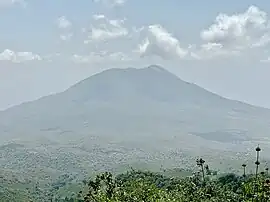Kerimasi
Kerimasi Volcano, also known as Kerimasi (Mlima Kerimasi, in Swahili) at 2,602 metres (8,537 ft) is an extinct shield volcano located in Monduli District of Arusha Region in Tanzania. The majority of the mountain lies in Engaruka Ward, and a quarter of it is in the Ngorongoro Conservation Area.[1] The volcano is located in the geographic area known as the Crater Highlands and is a shield volcano that last erupted in the Pleistocene.[2]
| Kerimasi | |
|---|---|
| Mlima Kerimasi (Swahili) | |
 Kerimasi from the west | |
| Highest point | |
| Peak | Kerimasi Peak |
| Elevation | 2,602 m (8,537 ft) |
| Coordinates | 2°52′25.32″S 35°57′10.08″E |
| Geography | |
| Country | |
| Region | Arusha Region |
| District | Monduli District |
| Geology | |
| Mountain type | Shield |
| Volcanic region | Crater Highlands |
| Last eruption | Pleistocene |
| Climbing | |
| Access | Public |
Geology and Mineral composition
Kerimasi, an extinct nephelinite volcano in northern Tanzania's eastern rift valley, emitted carbonatite tephra during its final eruptive phase. The tephra was primarily composed of alkali carbonatite, making it the earliest well-documented example of premodern natrocarbonatite volcanism. The main carbonate mineral was nyerereite, which is also the major mineral in present natrocarbonatite lava flows from the neighboring volcano Oldoinyo Lengai. Kerimasi's nyerereite was leached of its alkalis by meteoric water, and it is currently represented by calcite pseudomorphs.[3]
References
- Global Volcanism Program, 2023. St. Helens (321050) in [Database] Volcanoes of the World (v. 5.0.3; 1 Mar 2023). Distributed by Smithsonian Institution, compiled by Venzke, E. https://doi.org/10.5479/si.GVP.VOTW5-2022.5.0
- "Smithsonian, Kitumbeine overview". Retrieved 2023-03-26.
- Richard L. Hay; Natrocarbonatite tephra of Kerimasi volcano, Tanzania. Geology 1983;; 11 (10): 599–602. doi: https://doi.org/10.1130/0091-7613(1983)11<599:NTOKVT>2.0.CO;2